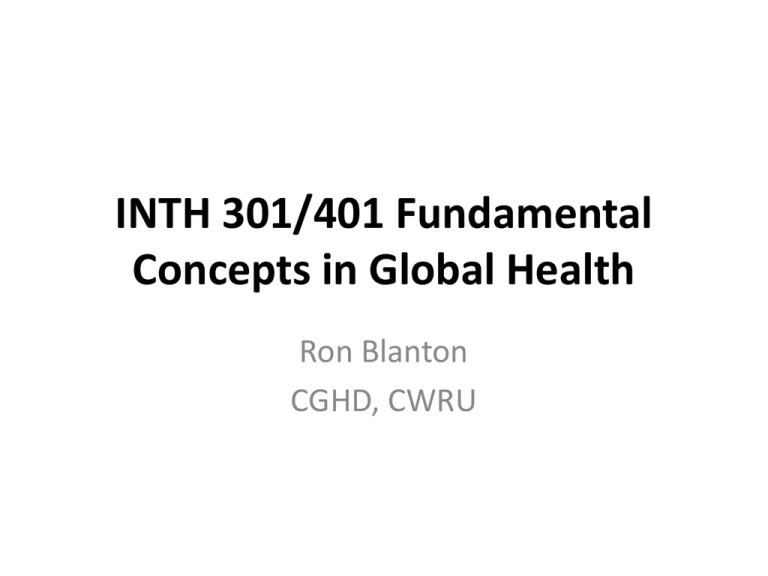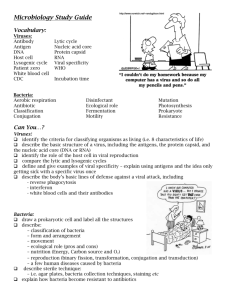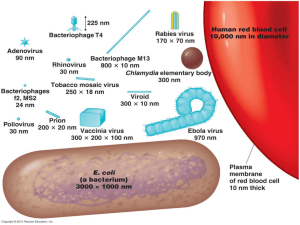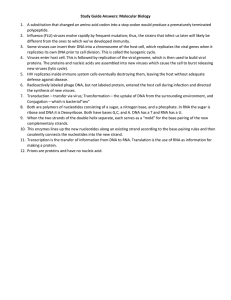General intro
advertisement

INTH 301/401 Fundamental Concepts in Global Health Ron Blanton CGHD, CWRU Infectious Agents of Disease • • • Viruses Bacteria Parasites Viruses • • • • Acellular organisms Nucleic Acids Origins Employ host cellular machinery to make proteins, nucleic acid and new virus • Do not divide • Do not generate/manipulate energy • Miniscule Viral Structure envelope 0.01-0.1 μm protein coat (capsid) Negative strand RNA polymerase Ribosomes DNA or RNA Classification • • • • Disease Transmission Nucleic Acid Sequence Classification • Disease – – – – – Cold Hepatitis Encephalitis Hemorrhagic fever Oncogenic • Transmission • Nucleic Acid • Sequence Classification • Disease • Transmission – Respiratory – Enterovirus – Arbovirus • Nucleic Acid • Sequence Classification • Disease • Transmission • Nucleic Acid – DNA – RNA • Sequence Nucleic Acid Classification Classification • • • • Disease Transmission Nucleic Acid Sequence – International Committee on Taxonomy of Viruses – 7 Genera DNA viruses – 15 Genera RNA viruses Classification Hemorrhagic Fever Viruses • Disease – Rift Valley Fever – Marburg, Ebola – Lassa, SAHF – Dengue, Yellow Fever • Nucleic Acid – RNA • Sequence – Bunyavirus – Filovirus – Arenavirus – Flavivirus Life cycle • Recognition - Receptor • Invasion • Transcription/translation or translation/transcription • Packaging • Release Flaviviral Replication Viral particle = virion Invading virion New virions RNA RNA Cell membrane Receptor Cap Proteases Mature proteins Cap Cap Cap Cap Cap Filoviral Replication Viral particle = virion Invading virion New virions RNA RNA Cell membrane Viral polymerase Cap Cap Cap CapCapCap CapCap Protein synthesis Receptor Implications • • • • • • Rapidly reproduced to high density Mutation Easily transported Wide host range (sometimes) Limited range of viral poisons Many modes of transmission Viral Tramission • • • • • • • • • • Respiratory Measles Respiratory-oral Colds Urine-Respiratory Hanta pulmonary syndrome Fecal-oral Rotavirus diarrhea Direct contact Chickenpox Veneral HIV Congenital Rubella Zoonoses Congo-Crimean Hemorrhagic Vector borne Dengue Transfusion Cytomegalovirus Virus and Disease • • • • Cytopathic effect Inhibit DNA, RNA protein synthesis Apotosis Proliferation Viral Prevention/Treatment • • • • Isolation (migration) Host Response Vaccination Antivirals Infectious Agents of Disease • • • Viruses Bacteria Parasites Bacteria • Simple cells • Cell membrane and wall (and envelope) • Reproduction by division Bacterial Structure LPS http://pathmicro.med.sc.edu/fox/protype.htm Gram Staining Reveals Structure E. coli http://www.buddycom.com/bacteria/gnc.html S. aureus “Bacterial Genetics” • Bacteria & Archea • Eukaryotes – – – – – Plant Yeast Parasites Insects People Implications • • • • • “Rapidly reproduce” in the right context Resistance Persistance Mutation/Gene transfer Toxin production Bacterial Prevention/Treatment • • • • Contact Host response Vaccines Antimicrobials/Antibiotics Infectious Agents of Disease • • • Viruses Bacteria Parasites Parasites • Single cell or multicellular eukaryotes living within a larger • Complex developmental programs Conceptual Basis of Parasitism SYMBIOSIS Commensalism Mutualism Parasitism Host - Parasite Relationships • Definitive host – – – – Echinococcosis Schistosomiasis Pork tapeworm Malaria = Sexual reproduction - dogs humans humans mosquito • Intermediate host = reproduction – – – – Echinococcosis Schistosomiasis Pork tapeworm Malaria - humans snail humans humans Asexual Parasitism in Human Biology and Medicine • • • • Parasite – usually refers to protozoa and helminths Distinction from other classes of infectious agents (bacteria and viruses) – historical significance more than biological distinction A ‘re-emerging’ cause of illness in industrialized nations. Health impact greatest in developing nations and among impoverished people Classification • Eukayrotes – membrane-bound organelles • Complex developmental programs Epidemiology and Clinical Characteristics • Protozoa (Microparasites) • Usually acute and transient infections • Disease initiated by small inoculum • Asymptomatic, acute • Distribution is random • Helminths (Macroparasites) • Chronic and persistent infections • Disease related to intensity of infection • Asymptomatic, chronic • Aggregated distribution Parasitic Protozoa Single cell organisms Multiply in human host Organelles analogous to tissues or organ systems Apicomplexa Include chloroplast-like structures Malaria, toxoplasma Archezoa Lack mitochondria, anaerobic Amebae Giardia lamblia Kinetoplastida Single large mitochondria Trypanosomes Leishmania Parasitic Helminths Multicellular Does not multiply in host Specialized organ systems Nematodes Round worms Platyhelminthes Flat worms Trematodes Flukes Cestodes Tapeworms Transmission of Parasitic Diseases • Fecal-oral route – common for food-borne pathogens, including Giardia lamblia and Entameba histolytica (protozoa), many geohelminths including Ascaris, Trichuris, Taenia (tapeworm) and Enterobius (pinworm) • Vector-borne – includes mollusks (snails) and multiple arthropods (mosquitoes, black flies). Examples are schistosomes, lung flukes, filarial worms, leishmaniasis, trypanosomiasis, malaria • Note: Vectors are required for completion of parasite life cycles. Not simply a vehicle for transfer to mammalian host. Parasite Disease Mechanisms • • • • Physical damage – invasion, attachment to tissues, tissue consumption, obstructions, parasite proteases and other products Innate immune responses – TNF-a, other cytokine production Immunopathology – host immune response leads to parasite containment coincidental with secondary tissue damage Spectrum of disease modified by transmission (i.e. intensity/chronicity of exposure), parasite burden and innate factors (genetic, immunologic, developmental) Additional Courses Medicine • • • • • • • INTH 484: Geographic Medicine and Epidemiology INTH 494: Infectious Disease Epidemiology INTH 5001: Orientation to International Health FAMD 5023: International Health Practice IMMU 3002 Tuberculosis and AIDS IMMU 3003: Tuberculosis and History EPBI 592: Geographic Information Systems and Statistical Analysis of Spatial Data




